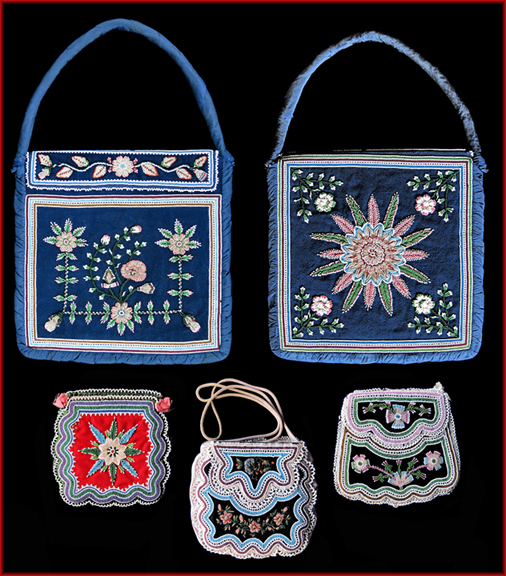This group illustrates another style that may have been introduced by the Parkers and subsequently developed by Tonawanda Seneca beadworkers. In the collection of the Rochester Museum and Science Center in Rochester, New York is a table cover that was made by Caroline Parker. Although it is undated, stylistic comparison to other similarly beaded items suggests it is from the mid-nineteenth century. The most prominent feature on the table cover is a large, central floral motif that distinguishes it stylistically from other floral work that was done during the mid-nineteenth century. It’s very similar to the large, central floral design on the upper right bag in the photograph above. I believe this motif, and its variations, are diagnostic of a style of floral beadwork that was done on the Tonawanda Reservation in western New York primarily by beadworkers in the Parker family; notably Caroline Parker, her mother Elizabeth, and Mariah, the wife of Caroline’s brother Levi. There may have been others in their immediate circle of beadworkers who were also involved in the production of this style.
These bags are distinguished by their many strings of beads, arranged in a tight band along a scalloped perimeter. They have pleasing color combinations in soft, contrasting hues, and a characteristic type of floral work.
“The art of flowering” is what these women were noted for. In describing how Caroline and her mother approached beadworking, Morgan wrote:
In doing this work, the eye and the taste are the chief reliances, as they use no patterns except as they may have seen them in the works of others [suggesting that they were not averse to borrowing the ideas or designs of other artists]. In combining colors certain general rules, the result of experience and observation, are followed, but beyond them each one pursued her own fancy. They never seek for strong contrasts, but break the force of it by interposing white, that the colors may blend harmoniously. Thus light blue and pink beads, with white beads between them, is a favorable combination; dark blue and yellow, with white between, is another; red and light blue, with white between, is another; and light purple and dark purple, with white between, is a fourth. Others might be added were it necessary. If this beadwork is critically examined it will be found that these general rules are strictly observed; and in so far beadwork embroidery may be called a systematic art. The art of flowering, as they term it, is the most difficult part of the beadwork, as it requires an accurate knowledge of the appearance of the flower, and the structure and condition of the plant at the stage in which it is represented (Morgan 1852:111).
Most of the bags we see in this style use these color combinations. Some of the finest examples have an exquisite, central floral motif on one side and this could be a Tonawanda Seneca identity marker. The large bag in this group may have been a presentation piece. The lower bag in the center is decorated in both beads and moosehair.
Morgan, Lewis Henry 1852 - Report on the Fabrics, Inventions, Implements and Utensils of the Iroquois, Made to the Regents of the University, Jan. 22, 1851. Illustrative of the Collection Annexed to the State Cabinet of Natural History, with Illustrations. Printed by Richard H. Pease, Albany.
